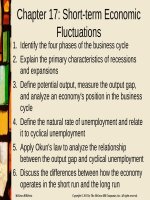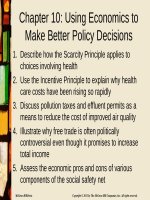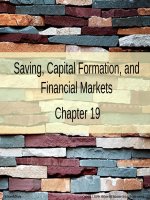Lecture Principles of economics (Asia Global Edition) - Chapter 26
Bạn đang xem bản rút gọn của tài liệu. Xem và tải ngay bản đầy đủ của tài liệu tại đây (675.37 KB, 52 trang )
Exchange Rates, International
Trade, and Capital Flows
Chapter 26
McGrawHill/Irwin
Copyright © 2015 by McGrawHill Education (Asia). All rights reserved.261
Learning Objectives
1.
2.
3.
4.
5.
Define the nominal exchange rate and discuss the
advantages and disadvantages of flexible versus fixed
exchange rates
Use supply and demand to analyze how the nominal
exchange rate is determined in the short run
Define the real exchange rate, summarize the law of one
price, and understand how purchasing power parity
determines the long-run real exchange rate
Use the relationship between domestic saving and the
trade balance to understand how domestic saving, the
trade balance, and net capital inflows are related
Analyze the factors that determine international capital
flows and how these flows affect domestic saving and
the domestic interest rate
262
The International Economy
•
•
•
•
Every day, news draws our attention to the global
economy
– The U.S. sub-prime mortgage crisis of 2007 – 2008
quickly became a worldwide event because of the
trade in mortgage securities
Since the mid 1980s, international trade has grown
twice as fast as world GDP
Changing trade patterns have reduced the sensitivity
of foreign economies to events in the U.S.
Innovations in transportation and communication can
make events abroad an immediate issue worldwide
263
Importance of Exchange Rates
•
Domestic purchases are made with local
currency
–
Purchasing goods abroad requires converting your
local currency to their local currency
•
•
The exchange rate measures the rate of conversion
Exchange rates are set in the foreign exchange
market, with a small number of exceptions
–
–
Rates are determined by supply and demand
Affect the value of imported goods and the value of
financial investments made across borders
•
Changes in exchange rates can have a significant
effect on most economies
264
Nominal Exchange Rates
•
The nominal exchange rate is the rate at which
two currencies can be traded for each other
Rates for
July 5, 2013
China (yuan, ¥)
Hong Kong (HK$)
Japan (¥)
Singapore (S$)
Thailand (baht, ฿)
Foreign Currency /
Dollar
6.132
7.755
100.940
1.281
31.240
Dollar / Foreign
Currency
0.163
0.129
0.010
0.781
0.032
265
Nominal Exchange Rates
•
Consider 3 currencies: US$, Singapore
dollars (S$), and Chinese yuan (¥)
–
–
One dollar buys ¥ 6.132 or S$ 1.281
The exchange rate between Chinese yuan
and Singaporean dollars can be calculated
from this information
¥ 6.132 = S$ 1.281
¥ 1 = S$ 1.281 / 6.132
¥ 1 = S$ 0.209
OR
S$ 1 = ¥ 6.132 / 1.281
S$ 1 = ¥ 4.787
266
4 1065
39865
38665
374 65
36265
35065
33865
100
32665
314 65
30265
29065
27865
26665
Exchange rat e index, 1973=100
U.S. Nominal Exchange Rate,
1973 - 2012
160
14 0
120
U.S. Nominal
exchange rate
80
60
40
20
0
Year
267
Changes in Exchange Rates
•
Appreciation is an increase in the value of a
currency relative to other currencies
–
Example: U.S. dollar appreciates when it goes from
$1 = £ 0.5 to $1 = £ 0.6
•
•
A dollar buys more of the foreign currency
Depreciation is a decrease in the value of a
currency relative to other currencies
–
Example: the Canadian dollar depreciates when it
goes from C$ 1 = ¥ 96 to C$ 1 = ¥ 95
•
A Canadian dollar buys fewer yen
268
Exchange Rates
•
Definition
–
e = the number of units of foreign currency that
each unit of domestic currency will buy
•
•
•
•
Example, e is the number of Japanese yen you can
buy with $1
e is the nominal exchange rate
Domestic currency appreciates if e increases
Domestic currency depreciates if e decreases
269
Exchange Rate Strategies
–
•
•
–
–
The foreign exchange market is the market on which
currencies of various nations are traded
A flexible exchange rate is an exchange rate whose
value is not officially fixed but varies according to the
supply and demand for the currency in the foreign
exchange market
A fixed exchange rate is an exchange rate set by
official government policy
Can be set independently or by agreement with a number
of other governments
Fixed rates can be set relative to the dollar, the euro, or
even gold
2610
Flexible Exchange Rate in the
Short Run
•
•
Exchange rates are set by supply and demand
in the foreign exchange market
US dollars are demanded by foreigners who
seek to purchase U.S. goods or financial assets
–
•
Number of dollars foreigners seek to buy
US dollars are supplied by U.S. residents who
need foreign currency to buy foreign goods or
financial assets
–
–
Not the same as the money supply set by the Fed
Number of dollars offered in exchange for other
currencies
2611
Supply of U.S. Dollars in
Foreign Exchange Market
•
Anyone who holds US$ is a potential supplier
–
•
US households and firms are the most common
suppliers
Supply curve has a positive slope
–
The more foreign currency each US dollar can buy,
the larger the quantity of dollars supplied
•
•
This makes foreign goods cheaper
When US$1 = ¥100, a ¥5,000 item costs US$50
–
–
If US$1 = ¥200, that same ¥5,000 item costs US$25
When the US dollar appreciates, the quantity of
dollars supplied increases
2612
Demand for U.S. Dollars in
Foreign Exchange Market
•
Anyone who holds yen can demand US dollars
–
•
Japanese households and firms are the most
common demanders
Demand curve has a negative slope
–
The more foreign currency needed to buy a dollar,
the smaller the quantity of dollars demanded
•
•
This makes U.S. goods more expensive
When US$1 = ¥100, a US$30 item costs ¥3,000
–
–
If US$1= ¥200, that same US$30 item costs ¥6,000
When the dollar appreciates, the quantity of dollars
demanded decreases
2613
•
•
Market for Dollars
Supply
of dollars
la
r
a
p
pr
e
ci
at
e
s
The market
equilibrium value of
the exchange rate
equates the quantities
of the currency
supplied and
demanded in the
foreign exchange
market
US dollar appreciates
e* increases
US dollar depreciates if
e* decreases
D
•
Yen/US dollar exchange
rate
ol
The Dollar – Yen Market
e*
Demand for
dollars
Q*
Quantity of US dollars traded
2614
Supply of U.S. Dollars in
Foreign Exchange Market
•
Supply of US dollars for Japanese yen is
determined by
–
The preference for Japanese goods
•
–
U.S. real GDP
•
–
The stronger the preference, the greater the supply
of US dollars
The higher GDP, the greater the supply of dollars
Real interest rate on Japanese assets and the real
interest rate on US assets
•
Supply of US dollars will be greater if
–
–
Real interest rate on Japanese assets is higher
Real interest rate on US assets is lower
2615
Initial equilibrium at E
Suppose consumers prefer
the new video game
system made in Japan
•
•
–
Increase in the supply of
US dollars shifts dollar
supply curve to the right
•
–
•
•
Shift in preferences
New equilibrium at F
US dollar depreciates to e*'
Quantity of US dollars
traded increases to Q*’
Yen / US dollar exchange rate
An Increase in the Supply of
U.S. Dollars
S
S'
e*
e*'
E
F
D
Q* Q*'
Quantity of US dollars
2616
Demand for U.S. Dollars in
Foreign Exchange Market
•
Demand for US dollars by holders of yen is
determined by
–
The preference for US goods
•
–
Real GDP in Japan
•
–
The stronger the preference, the greater the demand
for US dollars
The higher GDP, the greater the demand for dollars
Real interest rate on Japanese assets and real
interest rate on U.S. assets
•
Supply of US dollars will be greater if
–
–
Real interest rate on Japanese assets is lower
Real interest rate on U.S. assets is higher
2617
Strong Currency
•
A strong currency is unrelated to a strong
economy
–
–
–
•
US dollar was strong in 1973, a time of recession
The US dollar was weak in 2007 but the domestic
economy was strong
A strong currency means its value is high in terms
of other countries currencies
Strong currencies reduce net exports
–
–
Japanese goods look cheap, so NX goes down
Lower sales and profits for U.S. industries
2618
Monetary Policy and the
Exchange Rate
•
Monetary policy affects interest rates which
affect the exchange rate
–
–
Tighter U.S. monetary policy leads to a higher real
interest rate in the United States
Higher interest rates make U.S. assets more
attractive than foreign assets
•
Demand for the US dollar increases by foreigners
–
•
Supply of US dollars by U.S. decreases
–
–
Demand curve shifts to the right
Supply curve shifts to the left
US dollar appreciates
2619
Higher real interest
rates in U.S. increase
demand for US dollars
and decrease supply
US dollar appreciates
Change in quantity of
US dollars traded
depends on
•
•
•
–
–
Size of the two shifts
Slopes of the curves
Yen / US dollar exchange rate
Tighter Monetary Policy
S'
F
e
*'
S
E
e
*
D'
D
Quantity of US dollars
2620
Monetary Policy Results
•
U.S. Monetary policy was the main cause of
recent changes in the US dollar exchange rate
–
US dollar appreciation in the early 1980s
•
–
Real interest rate rose from negative values in 1979
and 1980 to over 5% in 1983 and 1984
US dollar depreciation 2002 - 2005
•
U.S. economy grew faster than our trading partners'
economies
–
•
Foreign exchange demand for imports increased
Fed funds rate went from 6% in 2001 to 1% in 2003
–
Demand for U.S. assets decreased
2621
Monetary Policy and the
Exchange Rate
•
Flexible exchange rates make monetary policy more
effective
– When the central bank tightens monetary policy, it
sets off a chain of domestic events
–
•
And a chain of international events
Monetary policy is more effective in an open
2622
Fixed Exchange Rates
•
Most large industrialized countries use a flexible
exchange rate
–
•
Fixed exchange rate system was set up after
World War II
–
–
•
Small and developing countries may use a fixed
exchange rate
Began to break down in the 1960s
Abandoned by 1976
Fixed exchange rates greatly reduce the
effectiveness of monetary policy as a
stabilization tool
2623
Fixed Exchange Rates
•
To establish a fixed exchange rate system, the
government states the value of its currency in
terms of a major currency
–
•
•
May use an average of the currencies of its major
trading partners
Government attempts to maintain the fixed
exchange rate at its existing level
The government may change the value of its
currency in response to market events
2624
•
•
•
Exchange Rates and Monetary
Policy
Flexible exchange rates strengthen the
effectiveness of monetary policy for stabilization
Fixed rates require the central bank to choose
between defending the currency and stabilizing the
economy
Fixed rates can be beneficial for small economies
–
Argentina fought hyperinflation by valuing its peso on
par with the dollar
•
•
Inflation quickly decreased and stayed stable for more
than 10 years
Fixed exchange system broke down because unsound
domestic policies created fears that Argentina would
default on international loans
2625









